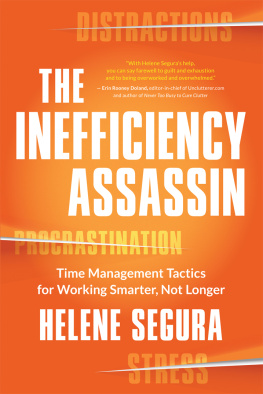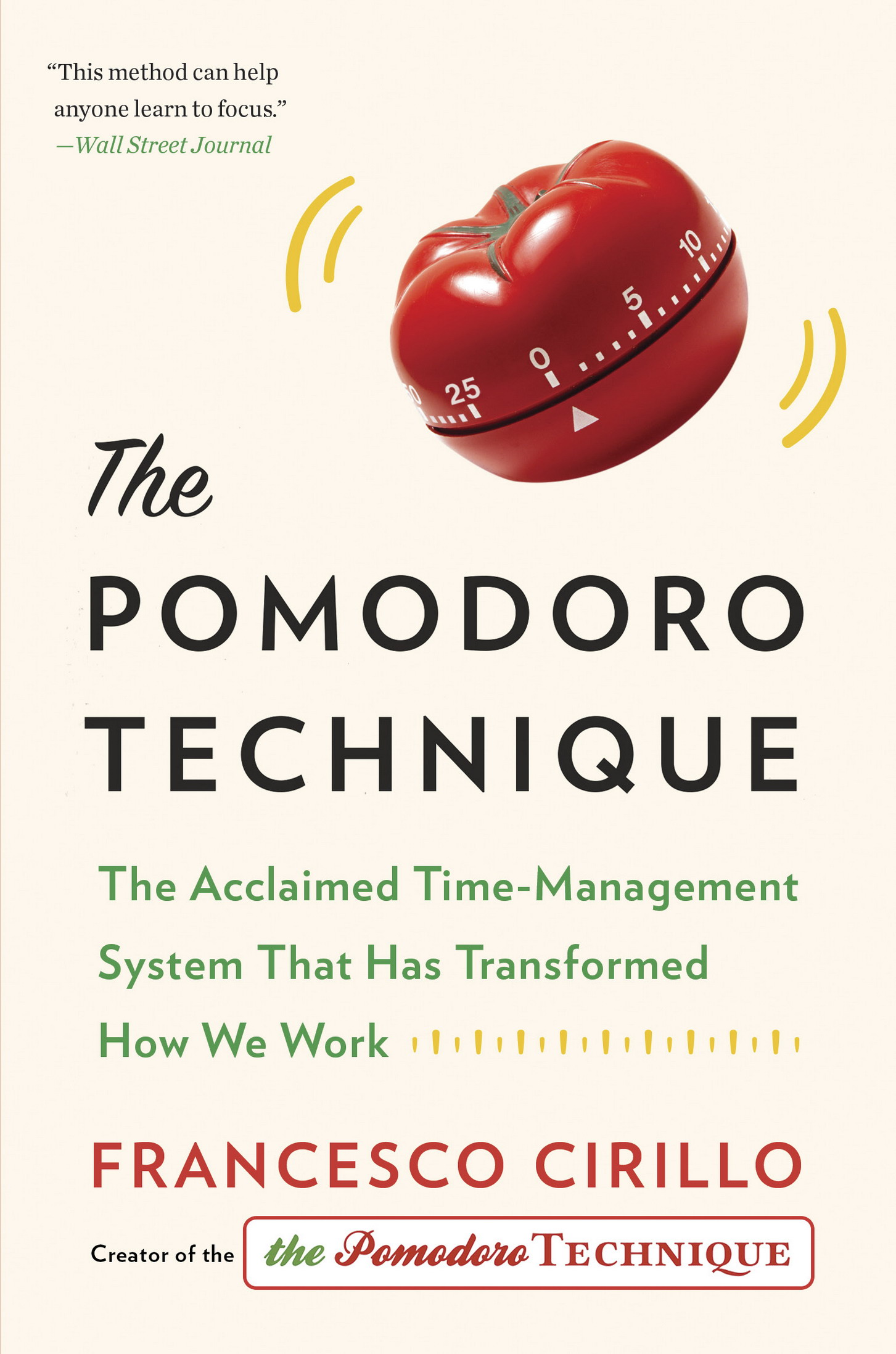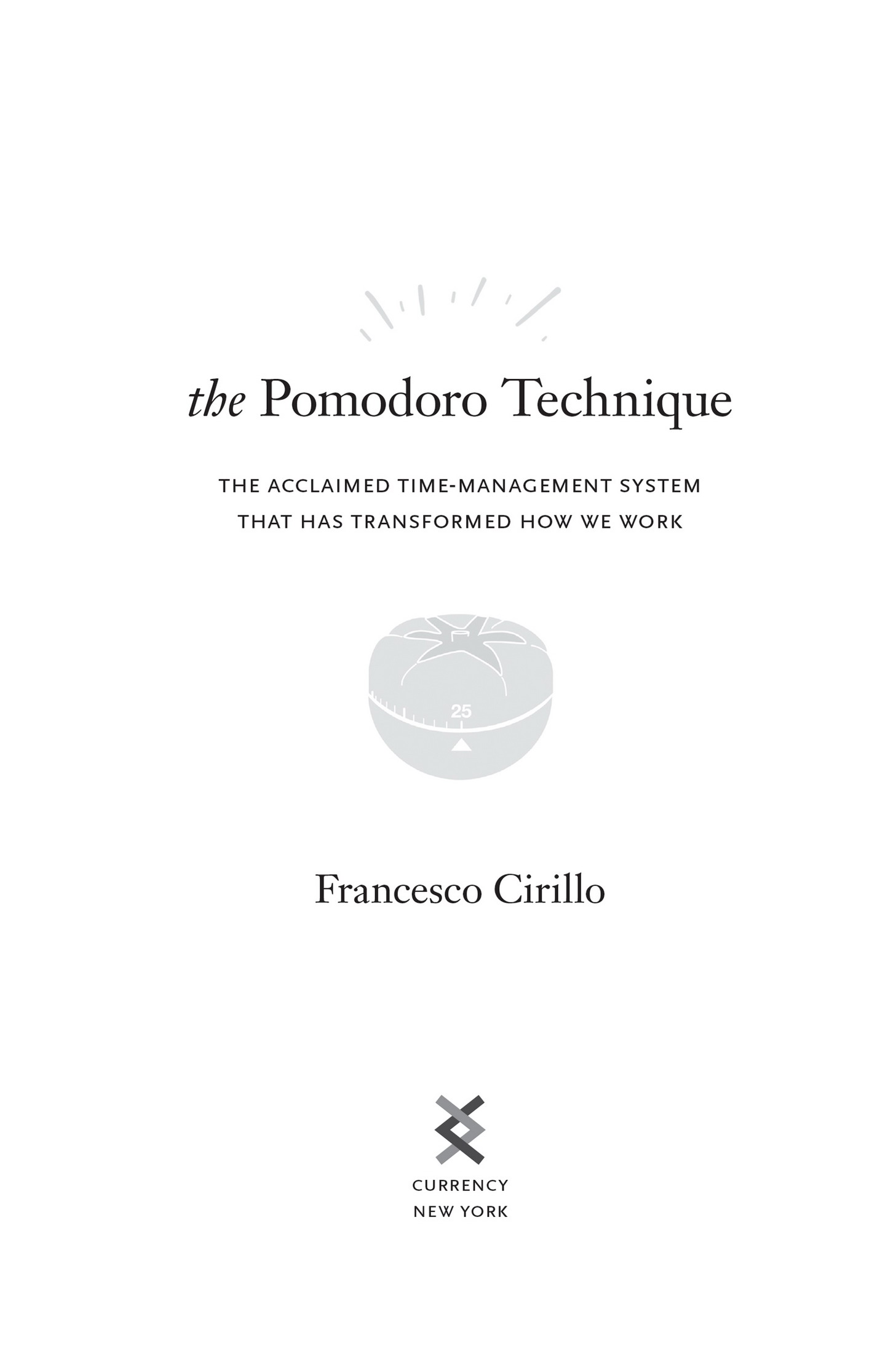All rights reserved.
Published in the United States by Currency, an imprint of the Crown Publishing Group, a division of Penguin Random House LLC, New York.
CURRENCY and its colophon are trademarks of Penguin Random House LLC.
Library of Congress Cataloging-in-Publication Data is available upon request.
PREFACE TO THE 2018 EDITION
I wound up the first Pomodoro on a cloudy September afternoon in 1987. The setting was the terrace of a house in a medieval village 30 miles north of RomeSutriwhere I spent my family holidays. The task was clear but scary: I want to finish this chapter. The chapter in question was the first of the sociology book I was reading for a university exam I had to take within a few weeks.
That afternoon, I never imagined that one day millions of people around the world would have repeated that same gesture of winding up a kitchen timer to beat distractions and reach their objectives within the set period of time. I never imagined that I would hear the sound of ticking timers in the background upon entering an open-space office full of brilliant software developers. And I would have thought it impossible for the CEO of a bank to use my same tomato-shaped timer to structure a board meeting. Or that the technique would be described in such prestigious publications as the New York Times, The Guardian, and Harvard Business Review. Yet, all that did happen. But how it happened still remains a pleasant mystery to me.
I clearly remember the sensation I felt when that Pomodoro rang for the first time: an unusual and unexplainable sense of calm. My mind had been drifting from one direction to another like a small boat at the mercy of a storm. I need to pass the exam. I have three books to study. Theres not much time until the exam. Ill never make it. I cant focus. Im always getting distracted. Maybe I should stop studying and postpone the exam. Maybe I should stop studying and do something else. After the Pomodoro rang, and that first timed work period was over, the sea was calm again: I knew I could do it. I remember wanting to set another Pomodoro. And I had set that first one for only two minutes, not the 25 I would come to find was ideal.
It was that sense of calmness and control I had regained that enabled me to pass the exam. And led me to start my own research into the phenomenon of Pomodoros: Why does it work? How long should a Pomodoro last? How many Pomodoros can you do in a day? How much rest between Pomodoros should I allow? It took a number of years to find the answers to those questions and to organize and structure them into a technique for improving productivity. I felt it was natural to name the technique I had developed the Pomodoro.
As I write this preface, the gentle ticking of that Pomodoro kitchen timer I used to prepare for the sociology exam is still with me. It has become an old friend. Thirty-one years have passed since that September afternoon in 1987. Many things have changed since then. The development of the Internet and social media have transformed our habits and behavior. Our smartphones let us know when we need to leave to get to the movies on time or when the dinner we ordered from the car or taxi on the way home is five minutes away from being delivered. Social media and various apps expose us to interruptions 24/7. So how is the Pomodoro Technique still effective in the digital age?
The most prolific source of distractions remains our own mind. What I call internal interruptionsthe sudden desire to order a pizza, update your social media status, or clean your deskcan still be more frequent and disruptive than the external ones, such as the ping of a new e-mail or a Facebook notification. The best approach to dealing with these interruptions is to accept them and treat them in a gentle way. The Pomodoro Technique invites you to write them down on your phone or computer or a piece of paper and deal with them once your Pomodoro is over. This way, you acknowledge their value and have time to consider and assess them properly to decide whether they are really important or not. If in a short space of time you experience too many internal interruptions, the Pomodoro Technique specifically requires you to stop and take a longer break.
The appearance of so many internal interruptions is our minds way of sending us a message: We are not at ease with what we are doing. This may be because the prospect of failing worries usit can be scary. Or maybe our goal seems too complex or we feel we are running out of time. To protect us, our minds come up with different, more reassuring activities. We end up favoring interruptions wherever we can latch on to them.
The type and frequency of interruptionswhether they are internal or externaldo not threaten the Pomodoro Technique. The technique helps us be aware of how our mind works and helps us to consciously decide how to deal with interruptions. Sometimes what pops into our head is truly urgent. But in most cases, it can be postponed for 20 minutes, until the end of the Pomodoro. Because interruptions are often just ways for our mind to distract us, taking us away from what we are supposed to be doing, this process can lead you to a better understanding of the fears that underlie your reaction to interruptions. Once you identify these fears, you can find ways to manage them. Without this process, our fears can take over and a fear of fear can paralyze us. The technique helps us develop a constant dialogue with ourselves, to observe ourselves and not delude ourselves. In any case, if you find yourself writing messages instead of focusing on your goal, do not worry: The next Pomodoro will go better. Be gentle with yourself.
PREFACE
The basic idea for the Pomodoro Technique came to me in the late 1980s, during my first years at college.
Once the elation from completing my first-year examinations had subsided, I found myself in a slump, a time of low productivity and high confusion. Every day I went to school, attended classes, and returned home with the disheartening feeling that I didnt know what Id been doing, that Id been wasting my time. The exam dates came up so fast, and it seemed that I had no way to defend myself against the passing of time.
One day in the classroom on campus where I used to study, I watched my classmates with a critical eye and then looked even more critically at myself: how I got myself organized, how I interacted with others, how I studied. It was clear that the high number of distractions and interruptions and the low level of concentration and motivation were at the root of the confusion I was feeling.













